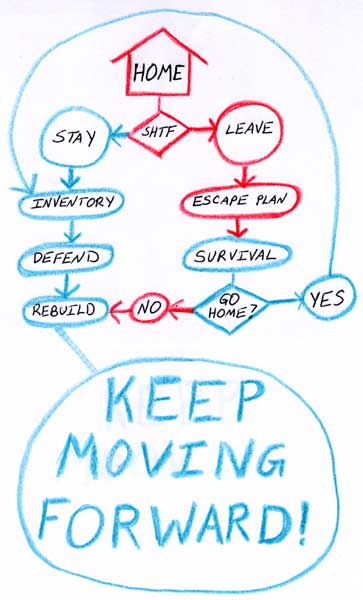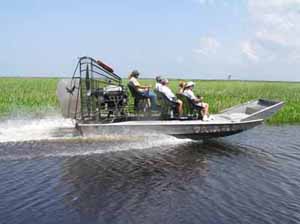ILISTENING TO KATRINA
PAGES IN THIS BLOG ARE RATED 'R' AND DO CONTAIN
PROFANITY, VULGARITY, GRAPHIC VIOLENCE, NUDITY,
SCENES OF HUMAN EMOTION, DEATH, DESTRUCTION, MAYHEM, AND VARIOUS
INDESCRIBABLE HORRORS.
PLAN - Lights, Camera, Action!
Timeline: Monday, August 29, 2005, 12:00 NOON CDT
Location: Varied
As I mentioned a two pages ago, I scribbled a brief action plan in a notebook on the same day Katrina made landfall. To me this was actually a new idea. It certainly wasn't something that I had read in any of the books or magazines. The books and magazines are more geared toward the idea that you're completely on your own, and you've got everything you need. Even in that eventuality, however, the books and magazines never tell you what you're supposed to do at that point. I guess you're just supposed to sit in your BOL, fend off the zombies, and eat until the food runs out. Nobody ever seems to give good advice on what to do after SHTF unless you count planting a sustenance crop good advice.
Let's have a crash course in Action Plans and cover a little theory.
Pop quiz: Your Escape and Bug Out Plans are specifically designed to do what?
That's right, boys and girls! Escape and Bug Out Plans are designed to safeguard Your Health and Your Wealth. There is also a set of plans that we haven't talked about yet - which are Bug In plans - but we aren't to a place where we can talk about those in context just yet. The Escape, Bug Out, and Bug In Plans all share similar features, and we reduce many things to common denominators in order to build generic but useful plans - and we use them to Escape, Bug Out, and safeguard Health and Wealth.
We'll call all of that The Parachute.
You very carefully make all of these plans, pack your 'chute, and board the airplane. Now the airplane is on fire, and it's time to Escape. You, being the clever person that you are, know that you can handle this because you have spent a lot of time on your parachute - so you jump out of the aircraft. Unfortunately, if you haven't had any training and nobody has given you any instructions then you might not know how to actually open that parachute...which gets messy after a few minutes because you're going to hit the ground pretty hard. Chances are, you will not have clean underwear at that point.
Exactly what to do after you exit the burning aircraft is your ACTION plan - and it's every bit as important as your Escape plan. While you may think it's overkill or a little crazy to create these ACTION plans and put them in your workbook, DO IT. As we go along and fill in some blanks in the next few dozen pages, there will be a number of things you will want to make notes on. In the very beginning I told you that if you approach a disaster as an opportunity, you can certainly do much more than simply survive. The ACTION plans are a road map for turning disaster into opportunity. Your ACTION plans can put you way ahead of the pack when the time comes. Your Escape and Evacuation Plans ensure that you survive. Your ACTION plans ensure that you *WIN* the disaster game.
Experiencing SHTF without a decent action plan is like jumping out of an airplane without a parachute. You *will* eventually land, but you may not be happy with the result. LAZY PEOPLE DO NOT PROSPER! I should know, because my dumb ass was in freefall for awhile before I figured it out...
Like the Escape and Bug Out plans, there aren't that many scenarios to cover. The two major contingencies are:
1. SHTF, and you're safe. 2. SHTF, and you're not safe.
'Safety' means several things in different contexts, but depending on that condition, there are really only two action plans.
| SAFE | NOT SAFE |
| Assess Communicate Transact Inventory Observe Navigate |
Assess Consolidate Tactics Improvise Observe Navigate |
Let's for a moment assume that you've made poor choices or had bad luck. You've decided to Bug In (stay home for the emergency) and things got a little out of hand. In the context of a hurricane, that usually means that your roof came off or the water came up. You are in a NOT SAFE condition, which means that you need to follow the NOT SAFE ACTION plan:
1. Assess - What is my situation? What do I need to do immediately to protect Health and Wealth? What is the immediate state of my shelter, food, water, and other immediate necessities?
The answers to those questions have so many possible answers that it is impossible to plan much further than that. You will have to make decisions on the fly. We'll get into some more detail on this as we take some case examples from Katrina and other disasters on a later page.
2. Consolidate - What resources are immediately available? Bring together necessary and available resources.
This may be as easy as making a five second mental review of the contents of your BOB, or it may mean scavenging supplies from destroyed homes. It may also mean consolidating resources with neighbors. Whatever you do in this stage, it means getting your shit together. Once you have an Assessment and have Consolidated resources, you can make some short term strategic decisions - like if you should stay where you are or move to better or higher ground.
3. Tactics - Once we have the Assessment, Consolidation, and short-term strategy, we need to work to put that strategy in motion by using good tactics. Your tactics may have to involve neighbors or other persons that you may have to think for. If their house collapsed or something and they ran to you for safety, then you may have to factor them in. Either that or turn them out.
4. Improvise - Just that. Like my friend Jerry says, "You'd be surprised what you can manage when you have a lack of a viable Plan B."
5. Observe - Keep your head up and your eyes open. Gather as much information as you can from as many sources as you can. Is what you are doing working? Do you need to do something different?
6. Navigate - Navigate means moving forward and continuing to make good or necessary decisions over time. That may continue to be a process of following the ACTION plan a second or third time - Assess (where am I now?), Consolidate, etc...
This is similar, if you recall, to the OODA loop, which is Observe, Orient, Decide, and Act - but there are some tricks and tips that come out when we use ACTION.

Let's go ahead and drag out the Flowchart of Strategy for a moment.
Where do our ACTION plans fit into this? Well for the Bug Out ACTION plan, it's the SURVIVAL part. For the Bug In ACTION plan, it's the [INVENTORY, DEFEND, REBUILD] part.
As we develop our ACTION plans, remember that our end goal is to KEEP MOVING FORWARD, and ultimately to go Home. We can't just survive and give ourselves a gold star. There is a lot of work to do in the middle, and the sooner we accomplish some critical tasks, the sooner we can work on our ultimate objective - Home.
If you are in a SAFE condition, then there is still work to do, but that work is a little different. We still use an ACTION plan, but the steps are a little different because our needs are different.
In a SAFE condition, our steps are:
1. Assess - What is my situation? What do I need to do immediately to protect Health and Wealth? What is the immediate state of my shelter, food, water, and other immediate necessities?
While the questions are the same, the answers are going to be different in a SAFE condition - but you still need to know the answers.
2. Communicate - This means reaching out to people, organizations, and government entities for information or assistance. You'll need to communicate with your insurance company, for instance, if you have a loss. You'll also need to communicate with FEMA if you are in a declared disaster area.
3. Transact - Once we have communicated, we need to follow through on that communication and perform other tasks to keep moving forward. Transact means to carry on or conduct (business, negotiations, activities, etc.) to a conclusion or settlement. HOME!
4. Inventory - Just that. Take stock of your wealth in every context. If you HYST, this should be easy.
5. Observe - Keep your head up and your eyes open. Gather as much information as you can from as many sources as you can. Is what you are doing working? Do you need to do something different? Is someone offering assistance that you can use? Is someone in need of assistance that you can provide?
6. Navigate - Navigate means moving forward and continuing to make good or necessary decisions over time. That may continue to be a process of following the the ACTION plan a second or third time. (Are you having that deja-vu feeling?)
As you can see, the foundation of ACTION plans isn't complicated. We are still going to create some pages in your workbook so that you can detail a few ACTION plans based on several scenarios. There will be a little redundancy between some of them, but that only means that our job will be easier. Unfortunately, there will be a few dragons along the way. FEMA being one of them...and FEMA is where we're going to start.
Gads... FEMA. OK, everybody go get your swords and put your armor on. This one is a real beast...
Shane
